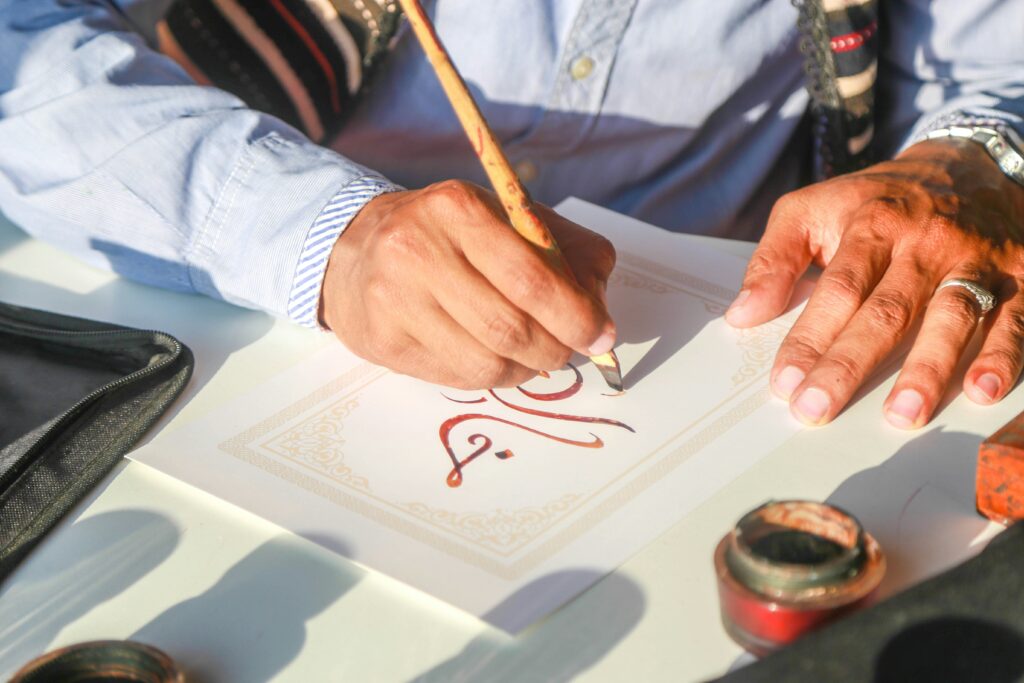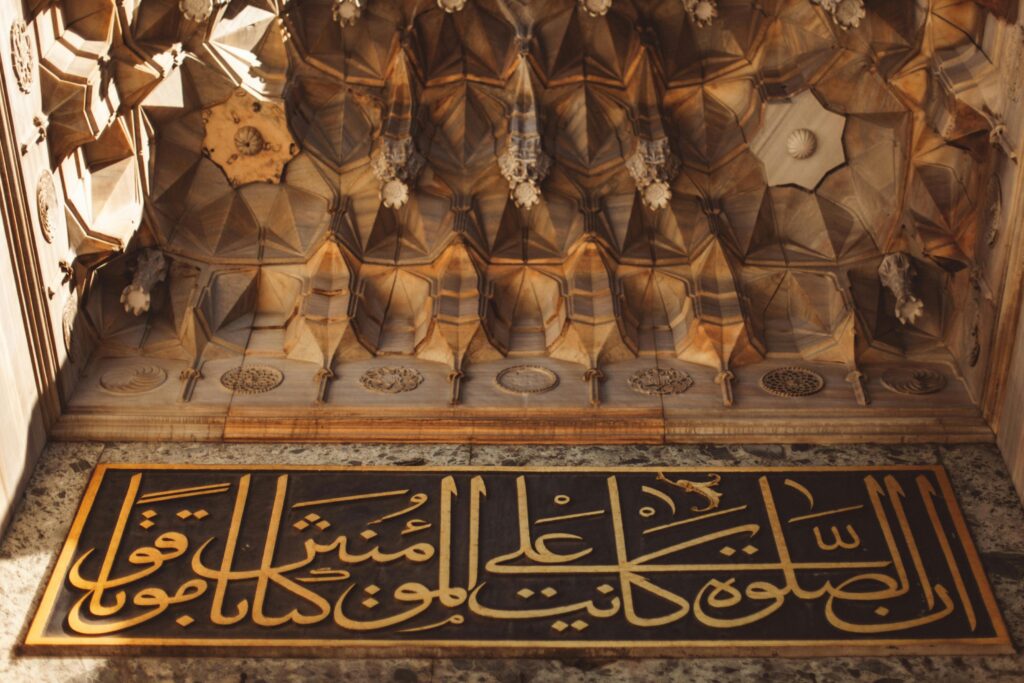Renowned Arabic Calligrapher Josh Berer Continues the Tradition
By Najia Shuaib
Nov/Dec 24

Josh Berer, initially interested in graffiti, got his formal exposure to calligraphy during one of his college Arabic classes. When the professor played a video of a calligrapher writing the Arabic alphabet, the written word immediately spoke to him, and he became determined to learn the craft by himself. He has never looked back.
English-German on one side, and Hungarian-Russian on the other, born to a mother who was a professor of Islamic art history, Berer seemed destined to become an Islamic traditional artist.
Among a few handful practitioners of Arabic calligraphy in the U.S Berer graduated in Arabic and Islamic Studies (University of Washington) and completed his Master’s in Central Asian languages (Indiana University). His timeline goes like this: a 2005 venture to major in Arabic at the university level, a 2007 move to Yemen to study Arabic full-time while taking beginner’s calligraphy sessions, and a 2009 trip to Istanbul that eventually turned his interest into a real passion.
During his stay in Istanbul, a chance meeting with one of the calligraphy world’s most respected voices changed the course of his life. He said, “Josh! If you’re serious about this art, look up [America’s master Islamic calligrapher] Mohamed Zakariya when you get back to America.” Upon return, Berer packed up his bags and moved to the District of Columbia to be a full-time apprentice under Zakariya’s guidance and teaching.
His 18-year journey, traveling through four countries and three languages, finally culminated in July 2020 when Zakariya awarded him Ijazah (master calligrapher’s license) in the Thuluth and Naskh scripts.
Exhibitions
Josh has exhibited his work extensively. However, two experiences stand out as remarkable in his memories. First, the Sharjah Calligraphy Biennial of 2022, where he exhibited alongside some of the most engaging and creative Arabic calligraphers working today, including Yemeni master calligrapher Zeki al-Hashemi, one of his earliest mentors. Driving across the UAE and visiting calligraphy festivals spread over three of the emirates was quite an experience for him.
The second was the Reed Society for Sacred Arts show “Living Line, Living Legacy,” which showcased the works of Zakariya and his graduated students Nihad Dukhan (professor of mechanical engineering, University of Detroit Mercy),Elinor Aishah Holland (a New York-based freelance lettering artist), Nuria Garcia Masip (a Spanish calligrapher of Arabic calligraphy), Pablo Khalid Casado (a Spanish master calligrapher), Manzar Moghbeli (a noted practitioner of Nasta’liq), Deniz Öktem Bektaş (an internationally recognized and classically trained Arabic calligraphy artist), and Berer himself — an exhibition by an extremely honorable group of calligraphers about which, he says, he was honored to be a part of.
The Journey Begins

Berer shares some great insights about learning Arabic calligraphy in this country. After starting his journey, he soon realized that “here in America no tools or ready-made supplies could be bought, so anything required must be made from scratch, at home. This requires a fair bit of innovation, alongside the traditional strategies, as the means and proper materials are not always available.” So, one must improvise. He also had to learn the fundamentals of the other, related art forms: the dyeing of paper, making of ink, paper marbling, etc. “That comes slowly, over time, and through much experimentation and waste.”
His first lesson with Zakariya will always be a captivating memory. He began with the traditional Ottoman curriculum by writing a du‘a (Rabbi yassir wa la tu‘assir [O Lord make it easy and not difficult) and the first half of the alphabet’s letters in the Thuluth and Naskh scripts. Zakariya cut two reed pens for him, one for each script, and wrote the lesson out with added measurement dots in red, while Josh carefully watched the master’s hand movements. The assignment was to attempt to copy it and bring it back the following week.
In the next session, he would correct his lesson to attempt it again. That practice continued week after week until it was written more or less perfectly, as are the letters. This system has reliably taught calligraphers for 500+ years.
After the rest of the alphabet, he needed to practice a long series of prescribed phrases, verses, and hadiths before getting his Ijazah in 2020. Berer is currently preparing another Ijazah piece for the Taliq script, the most difficult style to master. Given this reality, students are often advised to wait until one is an accomplished calligrapher before embarking upon it.
Why He Pursues Calligraphy
Discussing the responsibilities to preserve this sacred art in North America, Berer elaborates openly, “I work an extremely analog job in an extremely digital world. I cannot preserve traditional calligraphy techniques if the next generation of artists is not interested in learning them.” He and other North American traditional Islamic calligraphers are trying their best to produce quality work and continuously writing or speaking about these processes on different platforms. However, he believes that the next generation must be interested in learning this sacred art.
He admits that working with these techniques isn’t easy. It also takes a lot of steadfastness and resolution to keep practicing. But in the end the ultimate reward is producing decent art pieces by following the path of great masters, working days and nights to keep this sacred art alive, and leaving a good legacy behind to inspire future generations — a long hard road with no shortcuts, but it’s worth the effort.
Berer has also done extensive graphic design for clients to produce calligraphy for digital applications (e.g., websites and logo design, etc.) in the past, but now prefers to handle just the calligraphy portion and then pass it on to a professional graphic designer who can integrate it into its final context. He thinks that instead of consuming his time on the computer, he should focus more on calligraphy.
He adds that there is limited exposure/knowledge of traditional Islamic arts in the U.S., but there is also tremendous public curiosity and interest, which means that “when people go looking for someone who can practice these arts, they often end up in contact.” Though, a relatively small group of artists is practicing these traditional arts in North America, but everyone is very supportive and helpful. He believes that the future of Islamic art in the U.S. depends on what Muslim Americans want it to be. “The Muslim community is still young in this country, and the arts are often less of a focus for younger communities when it comes to where to direct resources.”
As a result, interested budding artists often face difficulty in finding the right resources for guidance, people who can help or direct them, and see very few inspiring examples around them. It isn’t anyone’s fault, he says. There’s just an absence of guidance. But there is a large degree of interest in learning Islamic traditional arts, and that must be encouraged and nurtured. “This means bringing in artists from outside to conduct workshops, as well as a strong will in students to travel and learn languages to pursue this form of art. It also means parents willing to support their children in non-STEM career paths as well.”
In a detailed piece of advice for interested people, Berer recommends looking at what they’re hoping to get out of it and the level of commitment (both time and money) they’re ready to devote. “For those just looking to get their feet wet and see how it goes,” he suggests taking an online course with the Deen Arts Foundation can be a great start. “For those interested in devoting a little bit more to it, several organizations or individuals are offering two-week summer traditional art tours of Istanbul.
“They arrange visits to the studios of calligraphers, Tezhip (ornamentation) artists, paper marblers, and bookbinders across the city for workshops and lessons. These tours help [one] to get acquainted with the city and its art scene. Staying an additional two weeks to make personal contacts with the calligraphers and artists one met along the way can prove to be very beneficial in the long run.”
Istanbul is a vibrant, international community of people who have moved there to learn the Islamic arts. After a month of doing art there, one can make sufficient contacts and formulate a path to move forward as an apprentice student of the classical arts, even from abroad.
For those interested in a career change or a life devoted to the traditional Islamic arts, Berer highly recommends either pursuing a degree program from Fatih Sultan Mehmet Vakıf University (Istanbul) or from the Kings Foundation School of Traditional Arts (London). He also suggests that moving to Istanbul for three or five years to apprentice with a teacher full-time can make this journey quicker, smoother, and more fruitful.
Najia Shuaib is a multifaceted freelance writer, visual artist, calligrapher, and Arabesque designer with a deep passion for Islamic traditional art. Her career has been dedicated to exploring the art, architecture, and archaeological history of the Middle East and Southeast, West, and Central Asia. She is now turning her attention to North America’s Muslim artists and the rich Islamic art collections featured in its museums.
